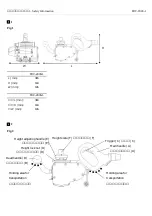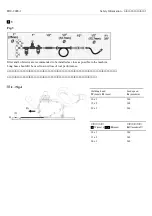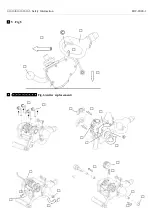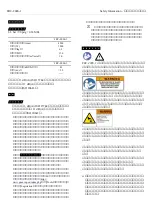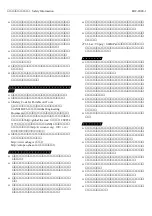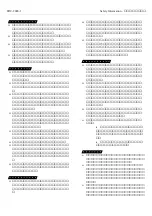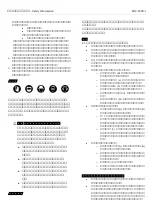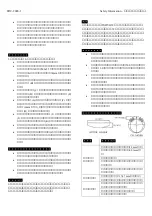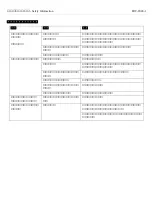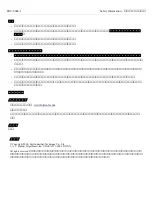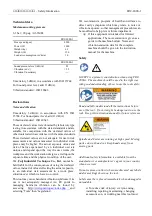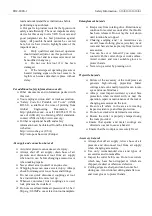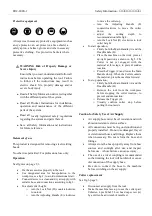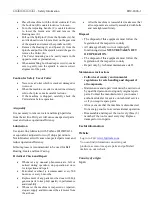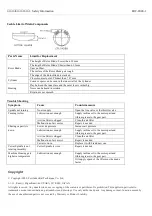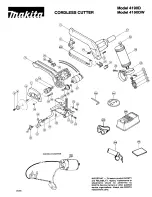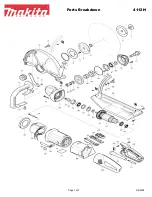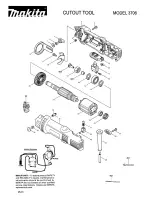
安全に関する情報
– Safety Information
FRC-200S-1
Operating hazards
Operators and maintenance personnel must be
physically able to handle the bulk, weight and
power of the tool.
Hold the tool correctly using both hands on the
handles: be ready to counteract sudden
movements.
Avoid injury by cutting or severing: avoid contact
with the cutter whenever the air supply is
connected to the tool. Wear protective equipment
such as gloves, apron and helmet.
Injury can be caused by uncontrolled movements
of the tool: always ensure that all of the base plate
is held firmly against the workpiece.
Cutting with these tools will create hot and sharp
edges on the workpiece. Wear gloves to protect
hands.
Always use sharp cutters.
Wait for the cutter to stop before setting the tool
down. An exposed rotating cutter may engage the
surface leading to possible loss of control and
serious injury.
Never force tool to cut faster or through heavier
gauge material than rated capacity.
Repetitive motion hazards
When using a power tool to perform work-related
activities, the operator might experience
discomfort in the hands, arms, shoulders, neck, or
other parts of the body.
Adopt a comfortable posture whilst maintaining
secure footing and avoiding awkward or off-
balance postures. Changing posture during
extended tasks can help avoid discomfort and
fatigue.
Do not ignore symptoms such as persistent or
recurring discomfort, pain, throbbing, aching,
tingling, numbness, burning sensation, or
stiffness. Stop using the tool, tell your employer
and consult a physician.
Noise and Vibration hazards
High sound levels can cause permanent hearing
loss and other problems such as tinnitus. Use
hearing protection as recommended by your
employer or occupational health and safety
regulations.
Exposure to vibration can cause disabling
damage to the nerves and blood supply of the
hands and arms. Wear warm clothing and keep
your hands warm and dry. If numbness, tingling,
pain or whitening of the skin occurs, stop using
tool, tell your employer and consult a physician.
Hold the tool in a light but safe grip because the
risk from vibration is generally greater when the
grip force is higher.
To prevent unnecessary increases in noise and
vibration levels:
Operate and maintain the tool, and select,
maintain and replace the accessories and
consumables, in accordance with this instruction
manual;
Use damping materials to prevent workpieces
from “ringing.”
Workplace hazards
Slip/Trip/Fall is a major cause of serious injury
or death. Be aware of excess hose left on the
walking or work surface.
Avoid inhaling dust or fumes or handling debris
from the work process which can cause ill health
(for example, cancer, birth defects, asthma
and/or dermatitis). Use dust extraction and wear
respiratory protective equipment when working
with materials which produce airborne particles.
Some dust created by power sanding, sawing,
grinding, drilling and other construction
activities contains chemicals known to the State
of California to cause cancer and birth defects or
other reproductive harm. Some examples of
these chemicals are:
Lead from lead-based paints
Crystalline silica bricks and cement and other
masonry products
Arsenic and chromium from chemically-
treated rubber
Your risk from these exposures varies, depending on
how often you do this type of work. To reduce your
exposure to these chemicals: work in a well-
ventilated area, and work with approved safety
equipment, such as dust masks that are specially
designed to filter out microscopic particles.
Proceed with care in unfamiliar surroundings.
Hidden hazards may exist, such as electric or
other utility lines.
This tool is not intended for use in potentially
explosive atmospheres and is not insulated from
coming into contact with electric power.
Summary of Contents for FRC-200S-1
Page 4: ...Safety Information FRC 200S 1 5 Fig 5 6 Fig 6 cutter replacement...
Page 5: ......
Page 6: ...Safety Information FRC 200S 1 JA 6 EN Safety Information 10...
Page 9: ...FRC 200S 1 Safety Information...
Page 10: ...Safety Information FRC 200S 1 2 3 2 3 o D o E o E o 4 o D o A B o 5 o C o A B o o C o...
Page 12: ...Safety Information FRC 200S 1...

